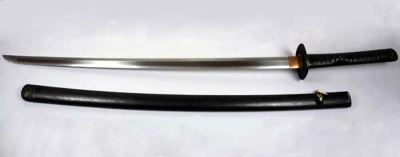Katana (1936.12.6)
 JapanKatana from Japan, Asia. Collected by General C. S. F. Fagan between 1870 and 1876. Given to the Museum by his son Major Fagan in 1936.
JapanKatana from Japan, Asia. Collected by General C. S. F. Fagan between 1870 and 1876. Given to the Museum by his son Major Fagan in 1936.
The katana is the archetypal sword of the samurai, said to embody his very soul. It gradually succeeded the longer tachi sword as the samurai's main weapon in the 14th and 15th centuries, due to the shift from cavalry to infantry tactics. Being shorter than a tachi and worn edge upward to permit a fast draw, it was more suited to hand-to-hand combat. As part of the samurai's civilian dress, it was often worn in combination with a matching shorter sword, called a wakizashi, to form a pair known as a daisho.
This example dates from around 1850 to 1865, the late Shinshinto ('new sword') period of sword-making when there was a revival of old styles and methods. This blade is probably a shortened copy of a 16th century tachi. Like all authentic Japanese swords, it has a fine, polished blade, made devastatingly effective by combining a hard steel edge with a softer, resilient core and back. It has a typical ray-skin hilt. the metal fittings are decorated with flowers and gilt butterflies and the black lacquered scabbard is incised with cloud-like patterns





